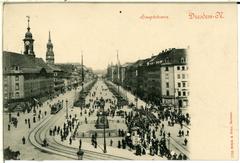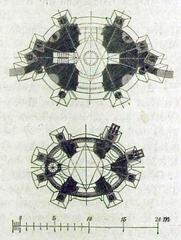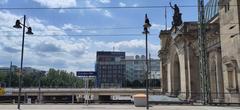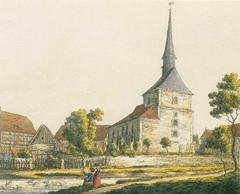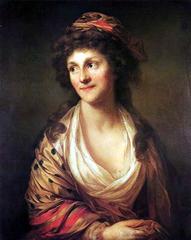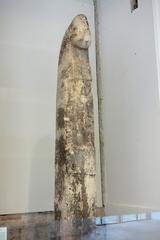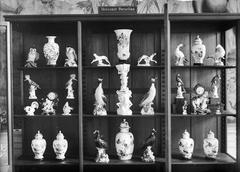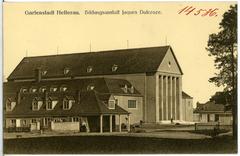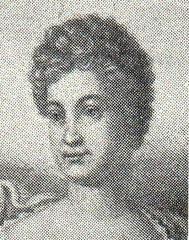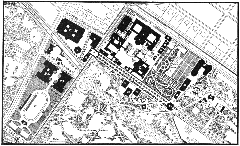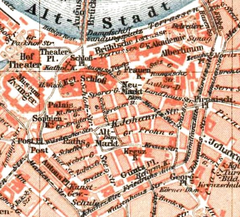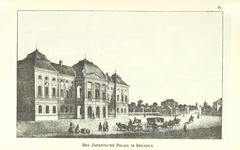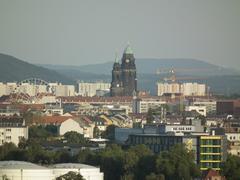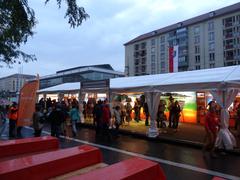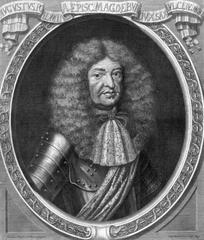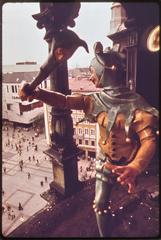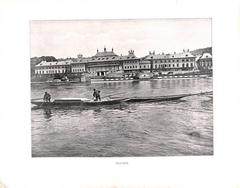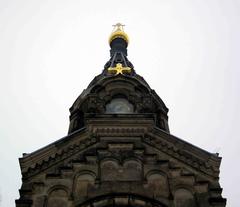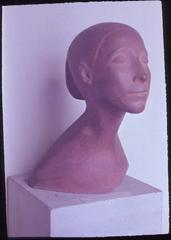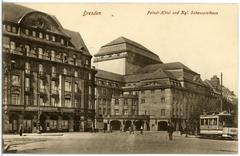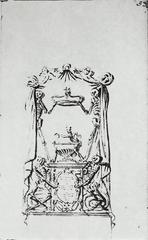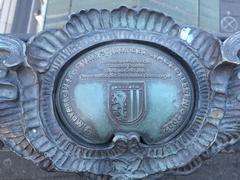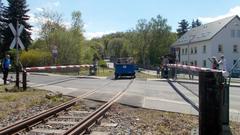Sekundogenitur Dresden: Comprehensive Guide to Visiting Hours, Tickets, and Historical Highlights
Date: 04/07/2025
Introduction
Set along Dresden’s renowned Brühl’s Terrace, the Sekundogenitur is a striking testament to the city’s aristocratic heritage, architectural splendor, and resilience through turbulent chapters of history. Originally built in the late 19th century as a residence and library for Prince Johann Georg—the second son of King George of Saxony—the building encapsulates the European tradition of providing for secondary royal lines. Today, the Sekundogenitur is celebrated not only for its neo-Baroque architecture and restored Baroque portal but also for its adaptive reuse as a sophisticated café and wine restaurant within the Hilton Dresden complex, offering visitors a unique opportunity to experience Dresden’s historical grandeur in a modern setting (aroundus.com; Wikipedia).
This guide provides detailed insights into Sekundogenitur’s history, architectural features, visiting information, accessibility, and its role within the broader landscape of Dresden’s cultural sites. Whether you are a history buff, architecture enthusiast, or traveler seeking authentic experiences, this resource will help you make the most of your visit.
Table of Contents
- Introduction
- Historical Development and Royal Origins
- Architectural Style and Features
- Transformations Through the 20th Century
- Destruction, Reconstruction, and Modern Use
- Visiting Information: Hours, Tickets, and Accessibility
- Travel Tips and Nearby Attractions
- Preservation and Heritage Status
- Frequently Asked Questions (FAQ)
- Visual and Interactive Elements
- References
Historical Development and Royal Origins
The Sekundogenitur was constructed between 1896 and 1897 after the demolition of the earlier Brühl Library and Old Academy of Fine Arts. Commissioned as a residence and library for Prince Johann Georg, the building reflects the tradition of “sekundogeniture,” or inheritance assigned to the second-born son in royal households—a practice common in European aristocracy (aroundus.com; Sachsens Schlösser). Its strategic location on Brühl’s Terrace—known as the “Balcony of Europe”—underscored its importance within Dresden’s cultural and social milieu.
Architectural Style and Features
Neo-Baroque Design
The Sekundogenitur stands as a refined example of late 19th-century neo-Baroque architecture, characterized by:
- Light-Colored Façade: Harmonizing with the historic ensemble along Brühl’s Terrace.
- Verdigris Copper Mansard Roof: A prominent feature that adds a distinctive silhouette to the cityscape.
- Elegant Portal: The Baroque Bacchus-Portal, attributed to Balthasar Permoser and salvaged from the Hellerschänke inn, was incorporated during the 1960s reconstruction, serving as a tangible link to Dresden’s Baroque heritage (Wikipedia).
The building’s rhythmic window arrangement, subtle pilasters, and restrained Rococo influences elevate its historical and aesthetic value (Petit Futé).
Transformations Through the 20th Century
With the fall of the Saxon monarchy in 1918, the Sekundogenitur shifted from a royal residence to a center for artistic and academic activities. It housed exhibitions for the neighboring Dresden Academy of Fine Arts and later served as a gallery for modern art. This adaptive reuse reflected Dresden’s evolving identity as a center of culture and innovation (aroundus.com).
Destruction, Reconstruction, and Modern Use
Wartime Destruction
The Sekundogenitur was heavily damaged during the Allied bombing raids of 1945, which devastated much of Dresden’s city center. The building’s shell stood as a stark reminder of wartime loss until the 1960s.
Reconstruction and Adaptive Reuse
Rebuilt between 1963 and 1964, the Sekundogenitur’s reconstruction focused on restoring its external neo-Baroque appearance and integrating the Baroque Bacchus-Portal. The interior was modernized to serve new cultural and hospitality functions.
Integration with Hilton Dresden
Since the late 1980s, Sekundogenitur has been part of the Hilton Dresden hotel complex, functioning as a café and wine restaurant. This adaptive reuse preserves its architectural integrity and ensures its continued relevance in Dresden’s urban landscape (Hilton Dresden; Petit Futé).
Visiting Information: Hours, Tickets, and Accessibility
Location
Brühl’s Terrace, 01067 Dresden, Germany
Opening Hours
- Café and Wine Restaurant: Generally open daily from 10:00 AM to 10:00 PM. Hours may vary by season or event—confirm with the Hilton Dresden official website before visiting.
Tickets and Entry
- Entry Fee: No separate ticket is required; visitors are welcome to experience the building by dining at the café or restaurant.
- Guided Tours: While no dedicated tours of the Sekundogenitur are regularly scheduled, many city walking tours of Brühl’s Terrace include the exterior and historical context of the building (Dresden Tourism Office).
Accessibility
The Sekundogenitur is wheelchair accessible, with ramps and modern facilities as part of the Hilton Dresden complex.
Travel Tips and Nearby Attractions
Best Time to Visit
- Seasons: Spring to early autumn provides pleasant weather for exploring Brühl’s Terrace and enjoying river views.
- Timing: Early mornings and weekdays see fewer crowds.
Getting There
- Public Transport: Easily accessible via tram and bus to “Theaterplatz.”
- Proximity: Within walking distance of Frauenkirche, the Albertinum, Zwinger Palace, and other Dresden landmarks.
Nearby Attractions
- Brühl’s Terrace: Offers panoramic views of the Elbe and Dresden skyline.
- Albertinum and Academy of Fine Arts: Art museums adjacent to the site.
- Frauenkirche and Zwinger Palace: Major historical and architectural highlights within a short walk.
Preservation and Heritage Status
Sekundogenitur is a listed monument protected by local and national heritage regulations. Its reconstruction and ongoing maintenance are guided by historical authenticity, with public engagement fostered through informational plaques and cultural events (Dresden Heritage Office).
Frequently Asked Questions (FAQ)
Q: Are tickets required to enter Sekundogenitur?
A: No separate tickets are needed. Access is via the café and restaurant.
Q: What are the opening hours?
A: Daily from 10:00 AM to 10:00 PM; verify current hours on the Hilton Dresden website.
Q: Is Sekundogenitur wheelchair accessible?
A: Yes, with ramps and accessible facilities.
Q: Are guided tours available?
A: General city and Brühl’s Terrace tours often include Sekundogenitur in their routes.
Q: What is the best time to visit?
A: Mornings or weekdays in spring to early autumn.
Visual and Interactive Elements
- Images: Feature high-resolution photos of the façade, Bacchus-Portal, and interior.
- Interactive Map: Display Sekundogenitur’s location relative to other Brühl’s Terrace landmarks.
- Virtual Tours: Check Dresden’s tourism website for digital resources (Dresden Tourism Office).
Summary and Visiting Tips
Sekundogenitur stands as a remarkable example of Dresden’s ability to bridge its royal past with modern vitality. Its accessible visiting hours, absence of entry fees, and proximity to major sites make it an inviting destination for travelers of all interests. Explore its neo-Baroque architecture, enjoy refreshments in its atmospheric café, and use it as a starting point to discover Dresden’s other cultural treasures (aroundus.com; Petit Futé; Dresden Tourism Office).
For the latest information, event listings, and guided tour options, consult the Hilton Dresden Hotel and Dresden Tourism Office. Download the Audiala app for audio guides and stay updated on special events.
References
- Sekundogenitur Dresden (aroundus.com)
- Sekundogenitur (Dresden) (Wikipedia)
- Dresden Reconstruction History (dokmimarlik.com)
- Dresden City Museum Visiting Info (stadtmuseum-dresden.de)
- Hilton Dresden Hotel (Hilton Dresden)
- Petit Futé Dresden Guide (Petit Futé)
- Dresden Tourism Office (Dresden Tourism Office)


